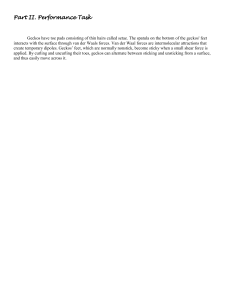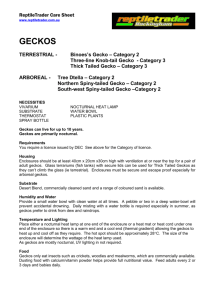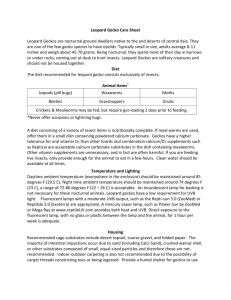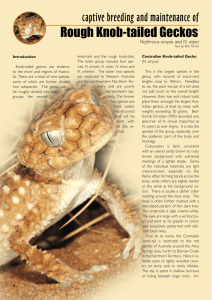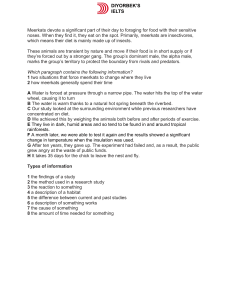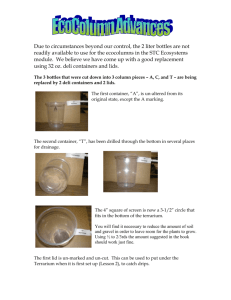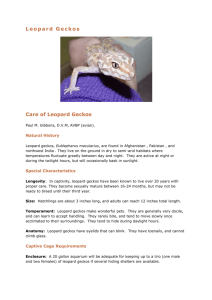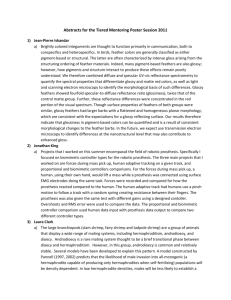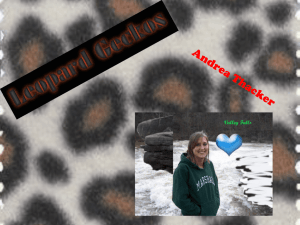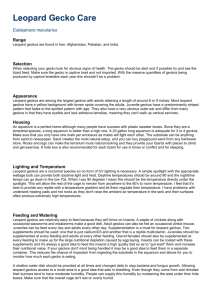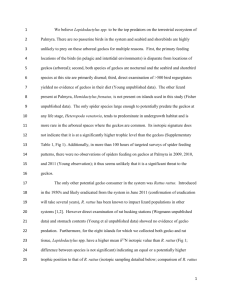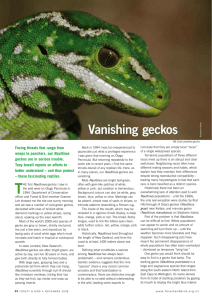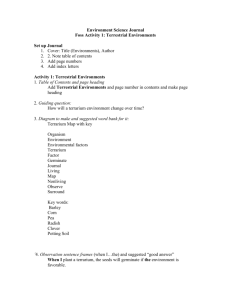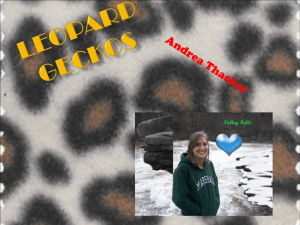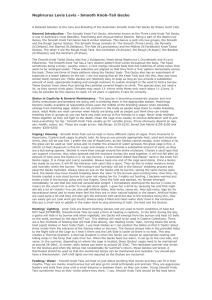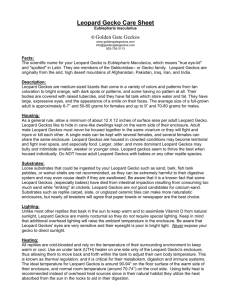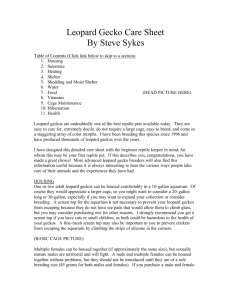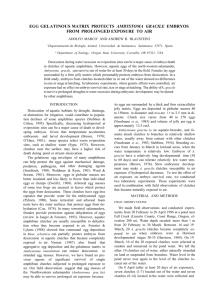Strophurus williamsi - By Andreas Laube
advertisement
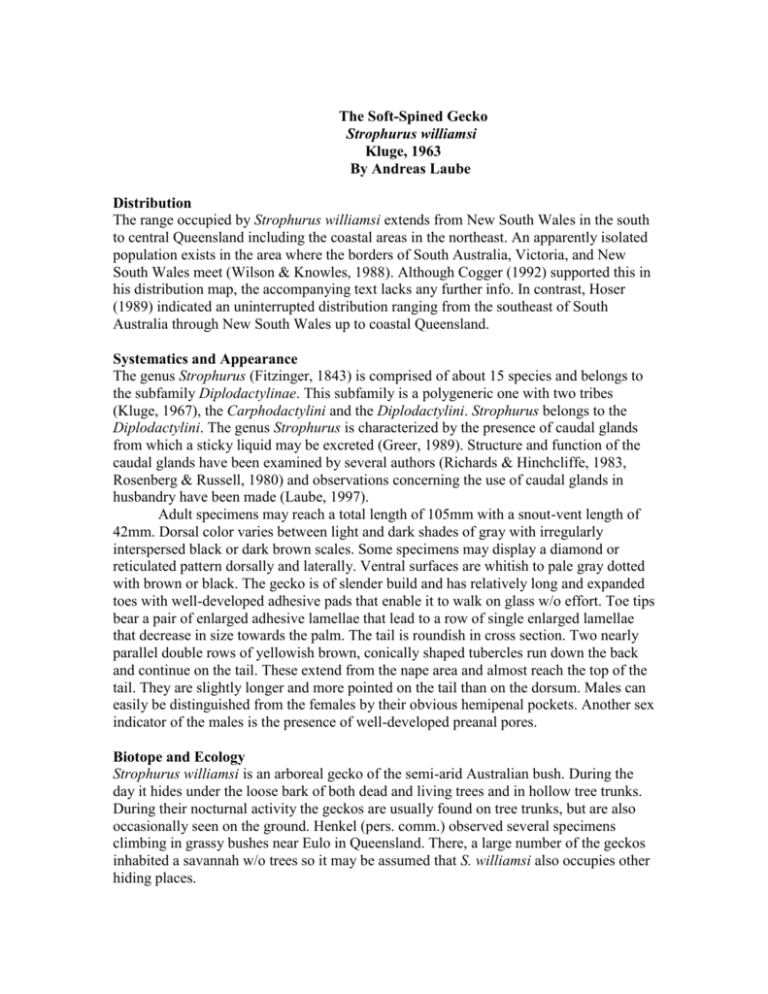
The Soft-Spined Gecko Strophurus williamsi Kluge, 1963 By Andreas Laube Distribution The range occupied by Strophurus williamsi extends from New South Wales in the south to central Queensland including the coastal areas in the northeast. An apparently isolated population exists in the area where the borders of South Australia, Victoria, and New South Wales meet (Wilson & Knowles, 1988). Although Cogger (1992) supported this in his distribution map, the accompanying text lacks any further info. In contrast, Hoser (1989) indicated an uninterrupted distribution ranging from the southeast of South Australia through New South Wales up to coastal Queensland. Systematics and Appearance The genus Strophurus (Fitzinger, 1843) is comprised of about 15 species and belongs to the subfamily Diplodactylinae. This subfamily is a polygeneric one with two tribes (Kluge, 1967), the Carphodactylini and the Diplodactylini. Strophurus belongs to the Diplodactylini. The genus Strophurus is characterized by the presence of caudal glands from which a sticky liquid may be excreted (Greer, 1989). Structure and function of the caudal glands have been examined by several authors (Richards & Hinchcliffe, 1983, Rosenberg & Russell, 1980) and observations concerning the use of caudal glands in husbandry have been made (Laube, 1997). Adult specimens may reach a total length of 105mm with a snout-vent length of 42mm. Dorsal color varies between light and dark shades of gray with irregularly interspersed black or dark brown scales. Some specimens may display a diamond or reticulated pattern dorsally and laterally. Ventral surfaces are whitish to pale gray dotted with brown or black. The gecko is of slender build and has relatively long and expanded toes with well-developed adhesive pads that enable it to walk on glass w/o effort. Toe tips bear a pair of enlarged adhesive lamellae that lead to a row of single enlarged lamellae that decrease in size towards the palm. The tail is roundish in cross section. Two nearly parallel double rows of yellowish brown, conically shaped tubercles run down the back and continue on the tail. These extend from the nape area and almost reach the top of the tail. They are slightly longer and more pointed on the tail than on the dorsum. Males can easily be distinguished from the females by their obvious hemipenal pockets. Another sex indicator of the males is the presence of well-developed preanal pores. Biotope and Ecology Strophurus williamsi is an arboreal gecko of the semi-arid Australian bush. During the day it hides under the loose bark of both dead and living trees and in hollow tree trunks. During their nocturnal activity the geckos are usually found on tree trunks, but are also occasionally seen on the ground. Henkel (pers. comm.) observed several specimens climbing in grassy bushes near Eulo in Queensland. There, a large number of the geckos inhabited a savannah w/o trees so it may be assumed that S. williamsi also occupies other hiding places. Husbandry and Behavior A terrarium measuring about 40 x 30 x 35cm ( LxWxH) suffices for the keeping of one pair. Keeping this species in pairs is recommended since males are aggressive towards one another, and if a male is kept together with several females, there is a good chance of unfertilized clutches. An appropriate substrate consists of peat and sand mixed at a ratio of 2:1. The cage is furnished with some pieces of cork, cork-tubes and a number of small branches. The side walls of the terrarium are covered with cork tiles. Suitable live plants are found among the small-growing species of Philodendron and Tillandsia. Day temps vary from 26-30C in summer and 20-24C in winter dropping to a low of 16C at night. The geckos become active immediately after switching off one of the terrarium illumination and maintain activity until early dwan. Adult geckos are fed two to three times a week with their diet consisting of mainly commercially bred crix of appropriate size, occasionally supplemented with wax moths and their caterpillars. All food is dusted with a vit/mineral powder. Sufficient quantities of food and a thorough supply of vitamins and minerals is particularly vital during the breeding periods. In the summer months, the terrarium is misted more or less daily, and the potential eggdeposition site is kept constantly moist. Misting is reduced to every other day in winter. The water used for spraying is also fortified w/ a liquid vit/mineral supplement. The geckos lick up drops that accumulate after misting, but also drink from a water bowl. During the day, the animals often spend their time lying on the thin climbing branches relying on their camouflage coloration. In case of possible danger they press themselves tightly to the branch. When actively climbing the tail serves as an additional leg. Having extremely flexible feet, the geckos can firmly grip around even very thin twigs or leaves and show great boldness in their movements. In general they are rather calm and never show hectic action, not even in stressful situations. Strophurus williamsi has the ability to squirt foul-smelling excreta from the glands embedded in its tail. This behavior is, however, displayed rarely and is limited to situations where the geckos are startled or surprised by being touched. The liquid can then be sprayed over a distance of up to 25cm, leaving cobweb-like threads from the tail to the squirted object. Afterwards, the posteriormost caudal glands usually retain small amounts of brownish liquid on their surfaces. This behavior is accompanied by the gecko gaping its mouth widely and emitting a barking sound that con most aptly be described as a short, vigorous, and relatively high-pitched caw. The blue interior of the mouth then becomes visible. This defense display is underlined by arching the back in a cat-like fashion and can be observed much more often than the squirting of the caudal excreta. Mating, Breeding and Rearing First mating activities can usually be observed in February. With the parental specimens being captive bred, the author is unaware of possible difficulties in adjusting the geckos to the seasonal rhythm of the northern hemisphere. Ronger (1992) reported that the female would pursue the male at this time – an observation this author cannot confirm. In the author’s experience, an attempts to mate were initiated by the male pursing the female and flicking his tongue frequently. A female uninterested in mating flees from the male and occasionally engages in defense behavior in the form of mouth gaping and barking. Ejecting the defense excreta, however, has never occurred in these situations. Matings mostly take place shortly after the illumination has been switched off and may take longer than an hour. The male continues to probe the female with his tongue in irregular intervals and only ceases to do so when he as eventually placed a holding bite on her. These bites are generally placed on the neck, a front leg or in the anterior lateral area of the body therefore bear witness that a mating has occurred. The male supports his hold by either wrapping his tail around a branch or around the body of the female. The first sign of gravidity is a change in the behavior of the female. She now tends to hang vertically on the walls of the terrarium during they day, very often head downwards. A few days prior to laying the eggs, she can be observed digging in the substrate of the cage. Before laying the eggs, the female usually rests in one of the selfdug pits for a day or two. Once the two soft-shelled eggs have been deposited, she spends about two hours closing the pit with soil. Similar motions are continued for quite some time thereafter in other regions of the terrarium, even on pieces of cork bark. Subsequent matings can be observed as early as one hour after the deposition of a clutch. The shortest gestation period recorded was seven weeks from the first mating observed. Females are capable of producing five clutches per year on average. These generally consist of two eggs each. Laying one egg only is an exception, and in all cases represented the first clutch of a breeding season. The intervals between clutches average three weeks, but Schroder (pers. comm.) reported up to seven clutches in one year laid in fortnightly intervals. These consisted w/o exception of two fertile eggs each. The eggs are oval and measure 16x9mm on average. They are incubated in slightly moist hydrogranulate and active charcoal mixed at a ration of 2.5:1. Initial experiments with vermiculite resulted in malformed hatchlings with crippled extremities or pop-eyes. Ulber (pers. comm.) has had similar experiences w/ vermiculite and this led to a switch to the said mixture that resulted in healthy juveniles. Considering the years of successful use of vermiculite by other terrarium keepers and even the author, it is to be presumed that the substrate was somehow contaminated and therefore should not be doubted as suitable for the incubation of soft-shelled reptile eggs. Provided with temps between 26 and 30C and a relative humidity of 70-80%, the 42mm to 48mm long juveniles emerge after 48-56 days. With only a few exceptions hatching takes place at night. The pattern of the hatchlings resembles that of the adults. Three to five days after emerging from their eggs the young geckos begin to feed and are for their first few months provided w/ food every day. Rearing them is generally easy, and sexes can first be distinguished at an age of five months. Under the conditions described above, the sex ratio of the offspring is about balanced. The first clutches of the offspring can be expected when the geckos are about nine and half months old but are usually infertile. At that stage the females measure 95mm in total length (38mm SVL). Based upon experiences with other gekkonid lizards it may be supposed that the males are not mature at this age and therefore are responsible for the unfertilized clutches. Acknowledgement Many thanks go to Thomas Ulber for the translation of my manuscript and his support w/ good advice as well as with photographs. Literature Cogger, H.G. 1992. Reptiles and Amphibians of Australia 5th Edition. Reed Books, Chatswood, NSW. 775pp. Fitzinger, L. 1843. Neue Klassifikation der Reptilien nach ihren naturlichen Verwandtschaften-Wien (Verlag J.G. Heubner), I-VI, 1-66. Greer, A.E. 1989. The Biology & Evolution of Australian Lizards. Surrey Beatty & Sons Pty Ltd, Chipping Norton, NSW. 264pp. Henkel, F.W. & W. Schmidt. 1991. Geckos: Biologie, Haltung und Zucht. Eugen Ulmer Verlag, Stuttgart. 224pp. Hoser, R.T. 1989. Australian Reptiles and Frogs. Pierson & Co., Mosman, NSW 238pp Kluge, A.G. 1967. Systematics, and Phylogeny and Zoogeography of the Lizard Genus Diplodactylus GRAY (Gekkonidae). Aust. Jour. Zool., 15:1007-1108. Laube, A. 1997. Bemerkungen zur erstmaligen Nachzucht und zum Abwehrverhalten des Juwelengeckos Diplodactylus (Strophurus) elder.i Striling & Zietz, 1893. Sauria 19(4): 41-44 Richardson, K.C. & P.M. Hinchliffe. 1983. Caudal glands and their secretions in the western spiny-tailed gecko, Diplodactylus spinigerus. Copeia 1983(1):161-169. Rogner, M. 1992. Echsen 1. Eugen Ulmer Verlag, Stuttagart. 281pp Rosenberg, H.I. & A.P. Russel. 1980. Structural and functional aspects of tail squirting: a unique defense mechanism of Diplodactylus (Reptilia:Gekkonidae). Can. J. Zool. 58:865881 Storr, G.M., L.A. Smith & R.E. Johnstone. 1990. Lizards of Western Australia III. Geckos and Pygopods. Western Australia Museum, Perth. 141pp Swanson, S. 1990. Lizards of Australia. William Collins Pty Ltd./Angus & Robertson, North Ryde, NSW. 160pp Ulber, T.W. Grossman, J. Beutelschiess & C. Beutelschiess. 1989. Terraritisch/Herpetologisches Fachworterbuch. Terrariengemeinschaft Berlin E.V., Berlin. 176pp Wilson, S.K. & D.G. Knowles. 1988. Australias Reptiles. A Photogenic Reference to the Terrestrial Reptiles of Australia. William Collins Pty. Ltd., Sydney. 447pp
